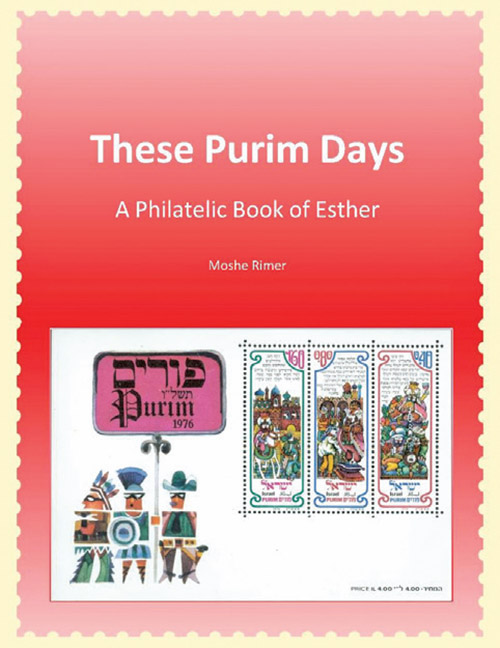

Have you ever seen a perush (biblical commentary) that mentions Elvis Presley? Do you know what Achashverosh’s palace in Shushan looked like? What does philately (stamp collecting) have to do with Purim? The answer to these questions can be found in a newly published edition of Megillat Esther.
Moshe Rimer, a noted Israeli collector, has created a commentary on Esther that merges his interest in Tanach with his interest in postal history. His Hebrew edition was published by the Israel Philatelic Federation, and as the librarian of the U.S. Society of Israel Philatelists (SIP) I received a copy and realized I could translate it for those more used to English sefarim. The SIP has published the translation, which stays true to the original in its high production value, the wonderful illustrations and the text. The translation also adds the brachot and trop to the original Hebrew text of the Megilla for ease of use during the Megilla reading.
The commentary is unique in how it merges interesting stories of stamp collecting around the world with the world of the Megilla and its story. For example, when Mordechai and Esther attempt to have King Achashverosh rescind his decree against the Jews, the commentary highlights this episode with the phenomenon of returning envelopes to the sender when the addressee cannot be found by the post office. Illustrated is a returned envelope bearing the stamp depicting Elvis Presley, whose song “Return to Sender” was a major hit. Such an envelope, returned to its sender, is desired by collectors. Each page of the Megilla text is connected with similar stories told in stamps.
The Royal Palace at Susa (Shushan) is depicted on several old stamps of Iran, where Susa is located. These and other stamps make the story of the Megilla come alive and show that the story is no mere fairy tale. The palace actually existed, and we know what it looked like!
Stamps of Israel from many periods are prominently featured, but they are far from the only stamps with a connection to the Megilla. Stamps from places as far-flung as Australia to Zaire, the Himalayan kingdom of Bhutan to the New Hebrides Islands in the South Pacific, Haiti to Syria and Greenland to the Belgian Congo can be found in this lavishly illustrated book.
The preface of the book describes the Persian Empire, which stretched at one time from India (Hodu in the Megilla) to Ethiopia (Kush). The postal services of this vast empire are described, using ancient Greek historians as sources. The commentary describes the many events in the Megilla transacted by mail, such as Achashverosh’s letter to his subjects forcing women to honor men and the letter sent by Mordechai and Esther instructing the Jews of the kingdom how to react to the evil decree of Haman, which itself was also sent by courier. The book shows us that collecting postal history is an age-old endeavor.
The preface also contains a discussion of the names of Mordechai and Esther, illustrated with stamps depicting some of the sources of the names. This is followed by the brachot of the Megilla reading and the text of the Megilla itself with its translation and the commentary. The book ends with discussions of Purim customs (including the local Purim celebrations like “Purim Vinz,” celebrated yearly by the Jews of Frankfurt-am-Main, Germany). The final section is a fun look at errors on postage stamps, all in the spirit of the Purim holiday.
This is a book fit for young and old, stamp collector or not. The book can serve as another way to keep the holiday of Purim fresh and pertinent. Anyone interested in purchasing this unusual and beautiful item can find it in several Teaneck Judaica stores or online under the “bookstore” tab at israelstamps.com, the SIP website.
By Dr. David Dubin













